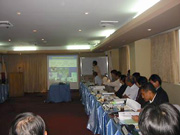Project News
2009-07-15
The 5th JCC Meeting

The 5th Joint Coordinating Committee Meeting, chaired by Dr. Cabral, assistant secretary of DPWH, was held on June 23th.The 32 attendants were Mr. Matsuda, chief representative of JICA Philippine Office, Mr. Hoshino, secretary of Japanese Embassy, JCC members of related department in DPWH, FCSEC staff and Japanese experts.
Mr. Matsuda and Mr. Yoshino gave a speech in the opening and closing of the meeting, respectively. They expressed their thanks to DPWH officials and said; that it is important FCSEC, as a permanent organization, fully utilize the knowledge and technology of human resources trained in this project in flood control in the Philippines.
Regarding this year’s activities and accomplishments and the future schedule, each C/P in charge of these subjects explained on the following;
Pilot project (Mr. Gil I. Iturralde);
In terms of Kinanliman River, the construction of dike (embankment) in Phase 2 started at the end of March 2009 and will be completed in the middle of July 2009. In Digmala River, about 80% of the constructions of Revetment and Spur Dike in Phase 1 were at present accomplished. It will be finished in the middle of July 2009. In Sta.Fe River, the construction of Sabo Dam using Soil-cement will start in October 2009.
Research and Development(Mr. Jessie C. felizardo) ;
Since 2007 up to this date, river modeling, bank slope erosion countermeasures and determination of runoff coefficient were accomplished in the laboratory hydraulic research in line with the activities for Pilot Project Output of Strengthening the Flood Management Function of DPWH and technical assistance to the academe. Also part of the research and development is the updating and revision of technical standards, guidelines and manuals for flood control and sabo engineering. This is necessary as there are now many documents produced since the start of technical cooperation project in 2000. To update the parameters used, consolidate the repeating chapters in the manuals and to keep abreast with the new technology, the revision is now on-going.
Information management and training (Mr. Michael T. Alpasan);
Seminar : “Test-filling through Soil-Cement Method for Sabo Dam”(Mar.5, 2009), “Debris Flow Breaker (Sabo Dam, Mar.25, 2009 Baguio City, Mar.27, 2009 Manila City)”Issue of Bulletins : News Letter, Vol. 3 (Dec. 2008)、Technical Report, Vol. 4 (Jun. 2009) Upgrade of Library : Preparation of Book List & Card, Purchase of New Books (29 Books) Training : “Planning and Design of Flood Control Structures”(Aug.,2008 OJT ; Sep.,2009)“Construction Supervision of Flood Control Project”(Sep.,2008), “Maintenance of Flood Control and Drainage Structures”(Sep.,2008), “Planning and design of Sabo Works”(Jun.,2009)
Internal support mechanism (Mr. Jerry A. Fano);
Technical Working Group Meeting : 6th (Apr.24,2008), 7th (May 29, 2008), 8th (Mar.26, 2009) Members(Representatives from DPWH bureaus, services, project management and other offices)supervised the activities and overall progress of the project.
Conduct of Master Plan / Feasibility Study for Flood Control in DPWH : FCSEC has collaborated with related DPWH offices and conducted the developmental Master Plan and Feasibility Study to formulate comprehensive and long-term development plans for flood control sector and principal rivers in the Philippines.(On-going)
Dr. Nakamura, chief adviser, gave a logical explanation about how external and prerequisite conditions are interacted with activities, accomplishments, project goal, upper goal, and super goal. He also called on all the attendants to closely cooperate with each other for the achievement of the goals. It was notified that the terminal evaluation for the project is to be carried out late January or early February in 2010.
Concerning the issue to maintain FCSEC as a permanent institution, Mr. David, director of FCSEC, argued as follows:
- For more than 9 years after its creation, FCSEC has accomplished much under the project. Project accomplishments include Technical Standards, Guidelines and Manuals, trained engineers, and established database on flood control and sabo, the initiation of hydraulic experiment and now under the SFMF project, FCSEC will be implementing pilot projects.
- Considering the above project accomplishments, FCSEC is proposed to be maintained in the restructured DPWH organization under the Rationalization Plan as the “Flood Management Center” (FMC), a permanent office directly under the Office of the Secretary.
Dr. Cabral also said they have not yet reached a conclusion under the current situation, but will make efforts to maintain FCSEC as a permanent institution.
In closing the meeting Mr. Matsuda gave the following comments:
- The activities seem to have been well enough performed despite the limitation that external conditions are not met enough, for example, a shortage of C/P and delay in the release of the project budget.
- Our utmost goal is to protect people and fortune from disasters. In achieving the goal, FCSEC activities play a very important role. Therefore it is of great significance to maintain FCSEC as a permanent organization as well as to secure enough engineers and budget.
- JICA is now preparing for extending a sector loan for disaster prevention. In order to carry out the project by the sector loan, we consider roles of FCSEC and its engineers to be essential.
- The Japanese government is going to attach great importance to the cooperation in the field of disaster prevention through “Cool Earth Partnership” as part of measures against climate change.
With one year to go till the completion of the project, we are expected to make the last efforts toward the success of the project.
- About JICA
- News & Features
- Countries & Regions
- Our Work
- Thematic Issues
- Types of Assistance
- Partnerships with Other Development Partners
- Climate Change / Environmental and Social Considerations
- Evaluations
- Compliance and Anti-corruption
- Science and Technology Cooperation on Global Issues
- Research
- JICA Development Studies Program / JICA Chair
- Support for the Acceptance of Foreign HRs / Multicultural and Inclusive Community
- Publications
- Investor Relations
